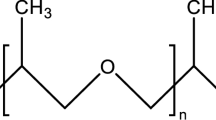Abstract
The curing of an epoxy-triphenol resin (ETP) using an amine curing agent in the presence of a polyorganosyloxane modifier is studied. It is shown that mixing of ETP with a modifier favors the formation of a completely compatible system, which, however, undergoes phase separation upon the curing. It has been established that curing of the epoxy-siloxane composite results in a denser mesh-structure buildup, while the cured samples exhibit higher deformation and strength characteristics and deformation heat resistance.
Similar content being viewed by others
References
S. N. Rusanova, S. Yu. Sof’ina, and O. V. Stoyanov, “Influence of organosilicon modifiers on structural characteristics and operational properties of polymers,” Vestn. Kazan. Tekhnol. Univ., No. 5, 85–89 (2008).
J. J. Chruściel and E. Leśniak, “Modification of epoxy resins with functional silanes, polysiloxanes, silsesquioxanes, silica and silicates,” Progr. Polym. Sci. 41, 67–121 (2015).
F. Piscitelli, M. Lavorgna, and G. G. Buonocore, “Peculiarities in the structure—properties relationship of epoxy-silica hybrids with highly organic siloxane domains,” Polymer 63, 222–229 (2015).
S. Najafi-Shoa, H. Roghani-Mamaqani, M. Salami-Kalajahi, et al., “Incorporation of epoxy resin and carbon nanotube into silica/siloxane network for improving thermal properties,” J. Mater. Sci. 51 (19), 9057–9073 (2016). doi 10.1007/s10853-016-0158-3
WO 2005078012A2 Switzerland, “Fire retardant compositions using siloxanes” (2005).
RF Patent No. 2209218, “The heat-resistant epoxy-silicone matrix for creating layered composite materials based on glass, carbon, boron and organic fibers” (2003).
N. G. Leonova, V. M. Mikhal’chuk, and E. P. Mamunya, “Thermophysical properties of epoxy-polysiloxane composites of cationic polymerization,” Entsikl. Inzh.-Khim., No. 12, 38–45 (2012).
I. Díaz, B. Chico, and D. de la Fuente, “Corrosion resistance of new epoxy–siloxane hybrid coatings. A laboratory study,” Progr. Org. Coat., No. 69, 278–286 (2010).
T. A. Akopova, Yu. V. Olikhova, and V. S. Osipchik, “A thermoanalytical study of curing of epoxy-amine binders modified with epoxy-containing silsesquioxane,” Polym. Sci., Ser. D 8 (2), pp. 133–137 (2015).
L. Kh. Nguen, Yu. V. Olikhova, and A. I. Kochetkov, “Features of epoxy phenol resin curing by aromatic amines,” Usp. Khim. Khim. Tekhnol. 29 (10), 35–37 (2015).
S. A. Vshivkov, S. N. Paznikova, E. V. Rusinova, and S. A. Evtyukhov, “Study of phase equilibrium by refractometry and determination of the second virial coefficients of the polymer–fire retardant system,” Pozharovzryvobezopasnost’ 16 (4), 34–36 (2007).
I. V. Chudnov, “Investigation of the properties of polymer binders by thermoanalytical methods,” Entsikl. Inzh.-Khim., No. 4, 30–35 (2013).
A. A. Gavrilov, P. I. Kos, and A. V. Chertovich, “Modeling of phase behavior and mechanical properties of ideal interpenetrating networks,” Vysokomol. Soedin., Ser. A 58 (6), 595–603 (2016).
Yu. S. Lipatov, T. T. Alekseeva, V. F. Rosovitskii, and N. V. Babkina, “Influence of the kinetics of the formation of interpenetrating polymer networks on their microphase separation,” Vysokomol. Soedin. 35 (6), 652–657 (1993).
US Patent 4250074A, Interpenetrating polymer network comprising epoxy polymer and polysiloxane (1981).
R. G. Jones, W. Ando, and Ju. Chojnowski, Silicon-Containing Polymers: The Science and Technology of Their Synthesis and Applications (Springer Science & Business Media, 2013).
D. F. Bergstrom, G. T. Burns, and G. T. Decker, “Insitu phase separation of an amine-terminated siloxane in epoxy matrices,” MRS Online Proc. Libr. doi 10.1557/proc-274-31
Author information
Authors and Affiliations
Corresponding author
Additional information
Original Russian Text © Yu.V. Olikhova, Nguen Le Khoang, N.V. Kostromina, V.M. Aristov, V.S. Osipchik, 2017, published in Klei, Germetiki, Tekhnologii, 2017, No. 7, pp. 7–11.
Rights and permissions
About this article
Cite this article
Olikhova, Y.V., Le Khoang, N., Kostromina, N.V. et al. An Epoxy-Siloxane Composite with Enhanced Deformation Heat Resistance and Improved Deformation and Strength Characteristics. Polym. Sci. Ser. D 11, 6–10 (2018). https://doi.org/10.1134/S199542121801015X
Received:
Published:
Issue Date:
DOI: https://doi.org/10.1134/S199542121801015X




